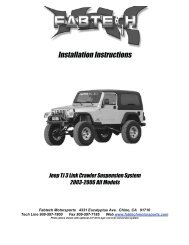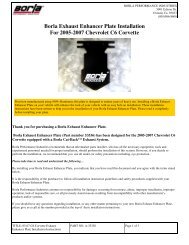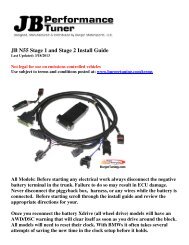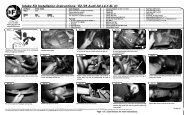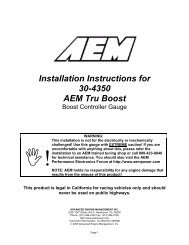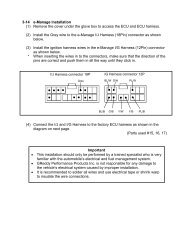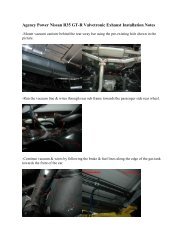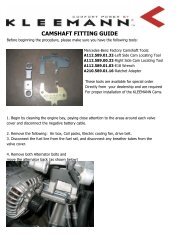Installation Instructions - Vivid Racing
Installation Instructions - Vivid Racing
Installation Instructions - Vivid Racing
Create successful ePaper yourself
Turn your PDF publications into a flip-book with our unique Google optimized e-Paper software.
www.vf-engineering.comPorsche 997 (US MODEL) Stage1 INSTALLATIONVF-ENGINEERING SUPERCHARGER KIT OWNERS MANUALThe following information and recommendations are designed to promote years of trouble freeservice for your supercharger. Care recommendations have also been outlined for your vehicle andmaintenance of your supercharger kit.MAINTENANCE INSTRUCTIONS FOR THE SUPERCHARGER KIT and SUPERCHARGER UNITCaring for your kit (mandatory procedures)1. After fitting, the new supercharger kit should be allowed to bed in for a run-in period of 300 miles during which the engineshould not be driven over 4500 rpm.2. The supercharger kit should be routinely inspected and maintained as below:ii. Air filters – Use the air filter system provided in your VF-Engineering system.iii. Air Intake / Air Discharge – Must be in good condition and properly secured. If equipped with flex hose, this must beFree of damage / leaks.iv. Belt Tension – Excessive belt tension can lead to supercharger or crankshaft bearing failure. Do not use a non-slippingor cog-type belt on a supercharger designed to be driven with a serpentine belt. Replacement belts for yourapplication, are available from VF-Engineering.v. Air Assist – The air assist system on certain Vortech superchargers must be kept free from kinks and leaks. Spareparts are available from VF-Engineering.3. Computer Chips – Use the computer chip or serial flash provided by VF-Engineering for this supercharger system. The use ofan aftermarket chip is not recommended as they would not be calibrated for use with a supercharger and can causedetonation. VF Engineering supplies a computer chip or serial flash with each kit that is specifically developed and calibratedto maximize performance.4. Crankcase Ventilation System – You must use the system provided in your VF-Engineering kit to prevent excessive crankcase pressures and possible engine damage. We recommend you clean or replace this every 6000 miles.5. Pullies – If your supercharger drive belt comes off it may be due to misalignment of the supercharger pulley cause byinstallation issues or movement of the mounting plate. Misalignment can also be caused by over-tightening (and failure) ofthe supercharger belt. For years of trouble free operation when used for street applications, we recommend the drive ratiosnot be changed from the standard specification.6. In case of recurring miss-firing or detonation / pinging you should contact your vendor. By following these procedures youwill ensure long term durability and reliability from your conversion.7. Clean the supercharger oil inlet fitting every 3-6000 miles. When the vehicle is cold, remove the oil inlet fitting at thesupercharger and clean it thoroughly utilizing high pressure air to blow the orifice clean before reinstallation. Do not attemptto remove the screen/filter inside the oil feed fitting. This oil inlet fitting is designed with a very small orifice, which providesa mist of oil directly onto the gears. Never use Teflon tape or other sealants on any oil feed line fitting. Do not over-tightenfittings.8. Do not use engine oil additives as they may contain solid particulates which can clog the supercharger feed line.MAINTENANCE OF YOUR SUPERCHARGED VEHICLE9. Before supercharging your vehicle we recommend you service and inspect your vehicle. Ideally the fault codes should bereset. This would highlight any existing conditions that may need attention. The condition of consumables, such as oil,filters, spark plugs, HT (plug wires) leads, ignition coil, and air mass sensor should be inspected and replaced whereneeded.10. Never operate your engine at full throttle when the engine is cold. When starting the engine each day, always allow plentyof time for the oil to reach full operating temperature before running above 2500 RPM. Full operating temperature isgenerally achieved only after the engine water temperature has reached the ‘normal’ indicated operating range for 2-3minutes.11. Always utilize the highest octane super (premium) unleaded fuel available in your area. Where possible try to use the samebrand of fuel. Where possible do not use fuels sold at low cost service stations and preferably use national brands wheneverpossible.12. After filling up with fuel from a source other than the one you use regularly, carefully listen for engine detonation. If anydetonation is audible, you may have a fuel problem. Cease utilizing heavy-throttle and drive with greater care until the fuelis consumed. If detonation is still evident, inspect for other causes such as:i. Faulty fuel pump(s). Check fuel pressure when detonation is occurring.ii. Dirty injector(s), clogged fuel filter or pinched fuel line.iii. Faulty spark plug(s) or spark plug wires with too much resistance. Consult your factory vehicle service manual. Mostwires should not exceed 10 Ohms of resistance.iv. Faulty ignition coil / distributor. Ask VF-Engineering for diagnostic info specific to your vehicle.v. Cooling system not functioning properly. Check for a faulty thermostat, faulty or improper calibration of the thermostaticfan switch, water pump belt slippage, a plugged radiator or bad fan clutch.vi. Dirty air filter / cleaner.13. Ensure the spark plug gap is correct for a supercharged application.14. We recommend using manufacturer recommended service components or taking the advice from our dealers specializing inthe different makes of cars.15. Spark Plugs need to be changed at intervals of 8-10,000 miles or sooner.16. Spark plug leads (wires) must be checked for condition. When reaching the end of their life, they become hard and must bereplaced as a complete set. Check the condition of your coil pack and test for resistance according to OE spec. Check thecondition of the distributor cap (where applicable) and replace if worn or heavily corroded. Replace rotor every 15,000 milesand cap every 50,000 or as condition warrant.17. Engine oil should be changed every 3-5,000 miles. We recommend OE oil. Do not mix different grades of oil qualities.PAGE 51 of 51P/N: VFM59-01© 2006 VF EngineeringAll rights reservedRev 1.11.21.06



